Deakin University HNN215: Quality Use of Medicine Case Study Analysis
VerifiedAdded on 2022/10/02
|10
|2723
|31
Case Study
AI Summary
This assignment analyzes a case study involving Ms. Candice Tong, a 56-year-old patient with hypertension, hyperlipidemia, and depression, who was admitted to the hospital with peptic ulcers. The analysis focuses on the quality use of medicines, exploring potential drug interactions and their associated risks, including hypotension, acute kidney injury, and bleeding. The assignment identifies interactions between prescribed medications such as ramipril, felodipine, clarithromycin, atorvastatin, warfarin, citalopram, and St. John's wort. It emphasizes the importance of patient education, regular monitoring, and reduction strategies in drug administration to mitigate risks. The case study also examines the implications of over-the-counter drug use and provides recommendations for safe medication practices, including the use of drug diaries and regular check-ups, highlighting the nurse's role in medication management and patient safety. Furthermore, the assignment underscores the significance of understanding drug side effects and the potential dangers of self-medication.
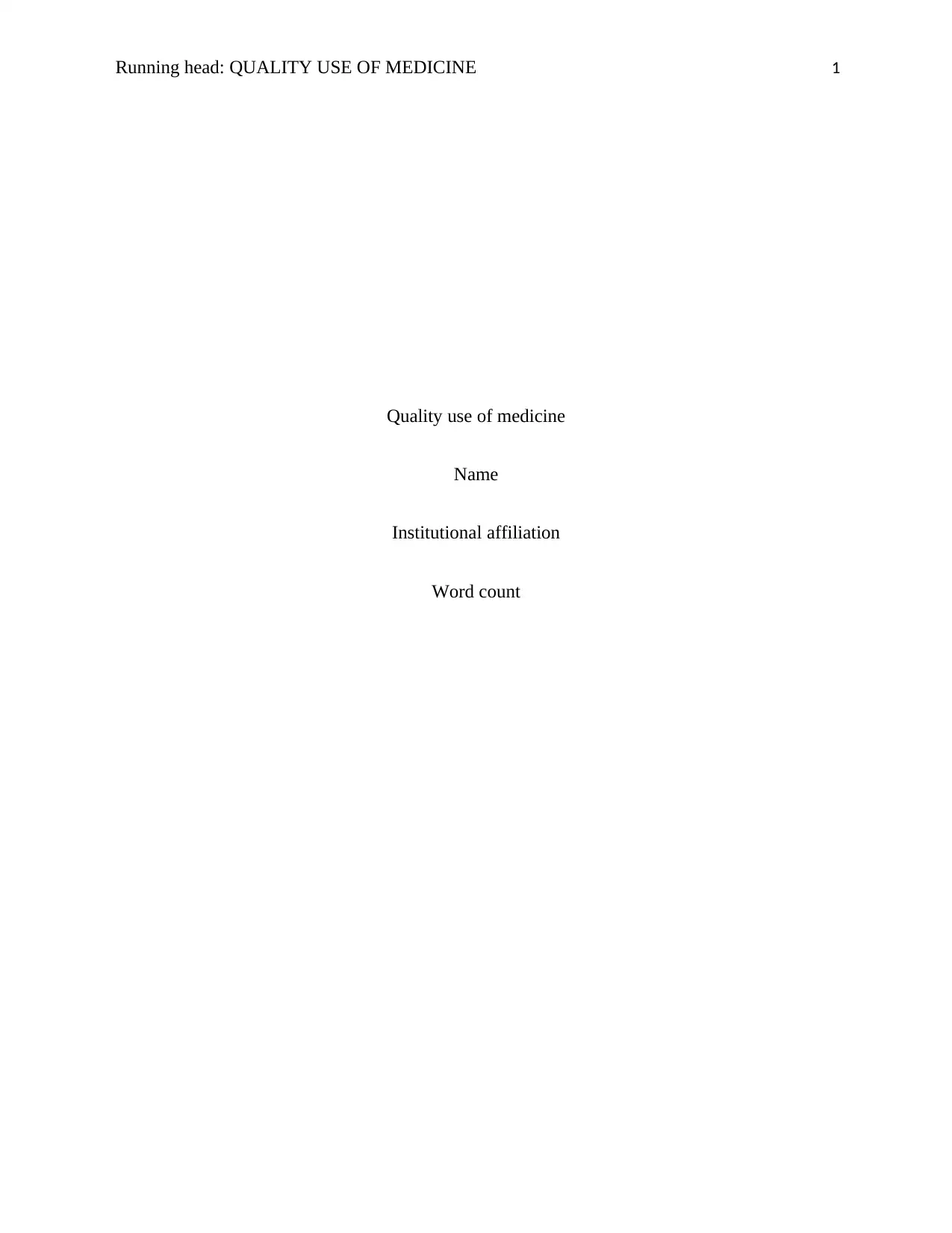
Running head: QUALITY USE OF MEDICINE 1
Quality use of medicine
Name
Institutional affiliation
Word count
Quality use of medicine
Name
Institutional affiliation
Word count
Paraphrase This Document
Need a fresh take? Get an instant paraphrase of this document with our AI Paraphraser
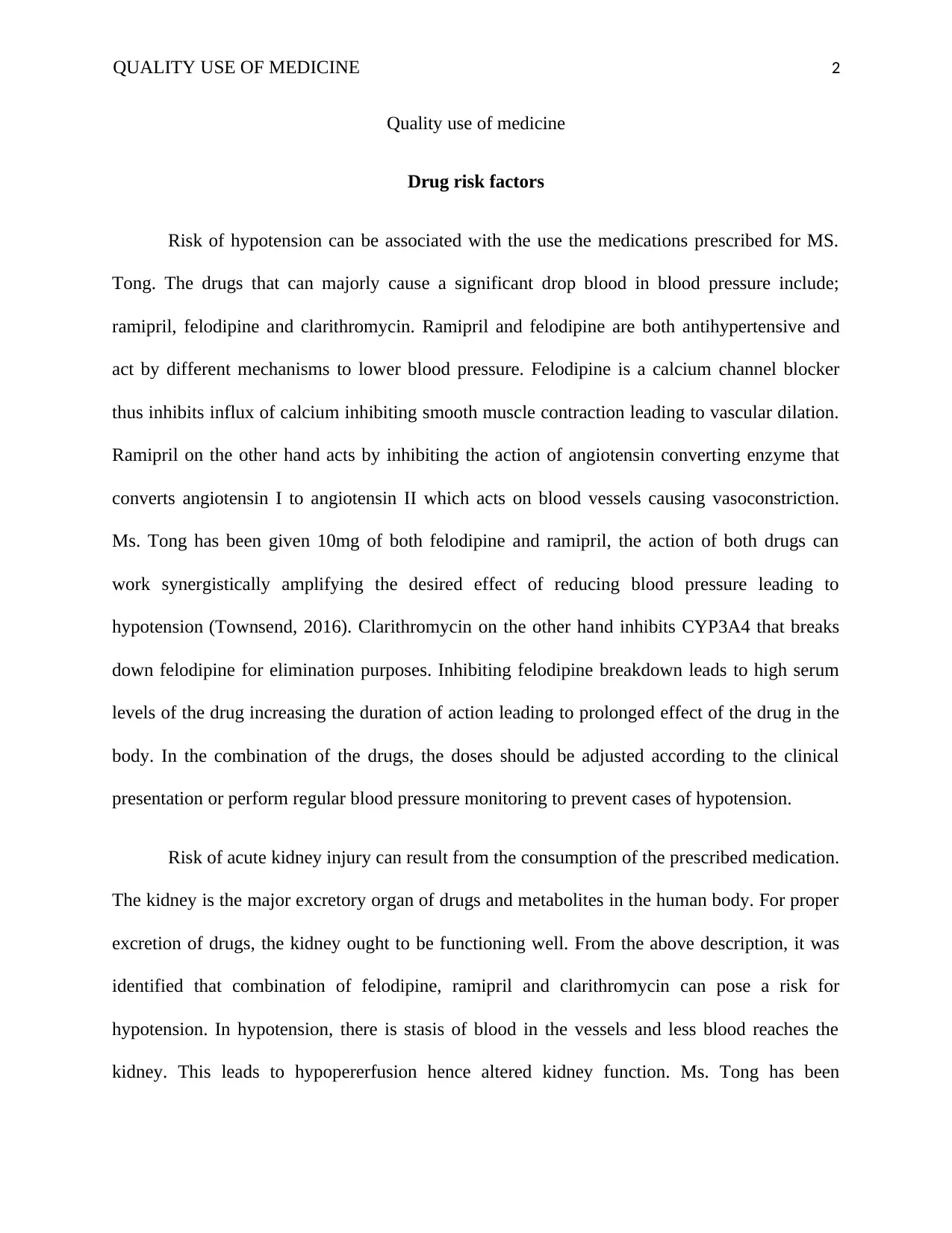
QUALITY USE OF MEDICINE 2
Quality use of medicine
Drug risk factors
Risk of hypotension can be associated with the use the medications prescribed for MS.
Tong. The drugs that can majorly cause a significant drop blood in blood pressure include;
ramipril, felodipine and clarithromycin. Ramipril and felodipine are both antihypertensive and
act by different mechanisms to lower blood pressure. Felodipine is a calcium channel blocker
thus inhibits influx of calcium inhibiting smooth muscle contraction leading to vascular dilation.
Ramipril on the other hand acts by inhibiting the action of angiotensin converting enzyme that
converts angiotensin I to angiotensin II which acts on blood vessels causing vasoconstriction.
Ms. Tong has been given 10mg of both felodipine and ramipril, the action of both drugs can
work synergistically amplifying the desired effect of reducing blood pressure leading to
hypotension (Townsend, 2016). Clarithromycin on the other hand inhibits CYP3A4 that breaks
down felodipine for elimination purposes. Inhibiting felodipine breakdown leads to high serum
levels of the drug increasing the duration of action leading to prolonged effect of the drug in the
body. In the combination of the drugs, the doses should be adjusted according to the clinical
presentation or perform regular blood pressure monitoring to prevent cases of hypotension.
Risk of acute kidney injury can result from the consumption of the prescribed medication.
The kidney is the major excretory organ of drugs and metabolites in the human body. For proper
excretion of drugs, the kidney ought to be functioning well. From the above description, it was
identified that combination of felodipine, ramipril and clarithromycin can pose a risk for
hypotension. In hypotension, there is stasis of blood in the vessels and less blood reaches the
kidney. This leads to hypopererfusion hence altered kidney function. Ms. Tong has been
Quality use of medicine
Drug risk factors
Risk of hypotension can be associated with the use the medications prescribed for MS.
Tong. The drugs that can majorly cause a significant drop blood in blood pressure include;
ramipril, felodipine and clarithromycin. Ramipril and felodipine are both antihypertensive and
act by different mechanisms to lower blood pressure. Felodipine is a calcium channel blocker
thus inhibits influx of calcium inhibiting smooth muscle contraction leading to vascular dilation.
Ramipril on the other hand acts by inhibiting the action of angiotensin converting enzyme that
converts angiotensin I to angiotensin II which acts on blood vessels causing vasoconstriction.
Ms. Tong has been given 10mg of both felodipine and ramipril, the action of both drugs can
work synergistically amplifying the desired effect of reducing blood pressure leading to
hypotension (Townsend, 2016). Clarithromycin on the other hand inhibits CYP3A4 that breaks
down felodipine for elimination purposes. Inhibiting felodipine breakdown leads to high serum
levels of the drug increasing the duration of action leading to prolonged effect of the drug in the
body. In the combination of the drugs, the doses should be adjusted according to the clinical
presentation or perform regular blood pressure monitoring to prevent cases of hypotension.
Risk of acute kidney injury can result from the consumption of the prescribed medication.
The kidney is the major excretory organ of drugs and metabolites in the human body. For proper
excretion of drugs, the kidney ought to be functioning well. From the above description, it was
identified that combination of felodipine, ramipril and clarithromycin can pose a risk for
hypotension. In hypotension, there is stasis of blood in the vessels and less blood reaches the
kidney. This leads to hypopererfusion hence altered kidney function. Ms. Tong has been
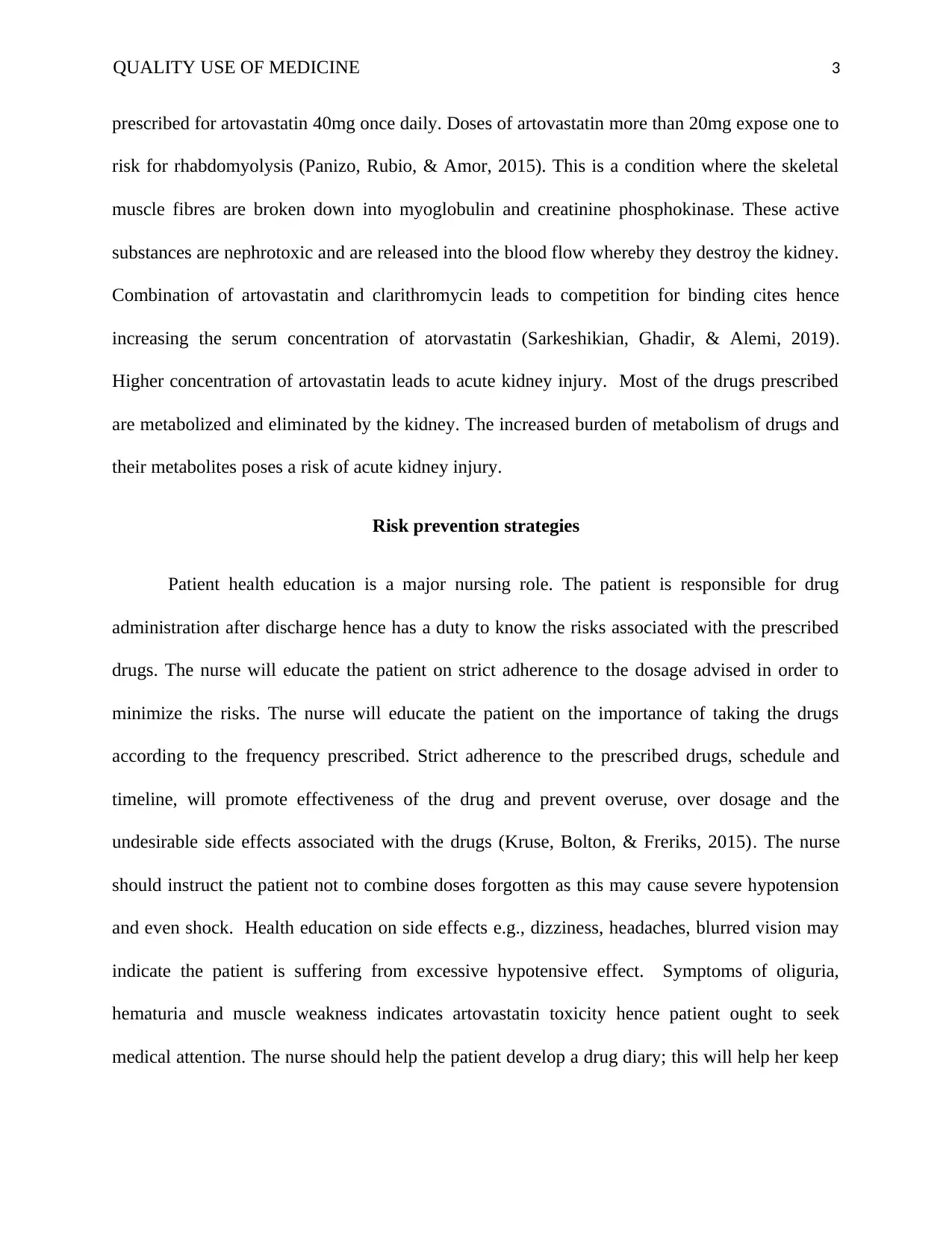
QUALITY USE OF MEDICINE 3
prescribed for artovastatin 40mg once daily. Doses of artovastatin more than 20mg expose one to
risk for rhabdomyolysis (Panizo, Rubio, & Amor, 2015). This is a condition where the skeletal
muscle fibres are broken down into myoglobulin and creatinine phosphokinase. These active
substances are nephrotoxic and are released into the blood flow whereby they destroy the kidney.
Combination of artovastatin and clarithromycin leads to competition for binding cites hence
increasing the serum concentration of atorvastatin (Sarkeshikian, Ghadir, & Alemi, 2019).
Higher concentration of artovastatin leads to acute kidney injury. Most of the drugs prescribed
are metabolized and eliminated by the kidney. The increased burden of metabolism of drugs and
their metabolites poses a risk of acute kidney injury.
Risk prevention strategies
Patient health education is a major nursing role. The patient is responsible for drug
administration after discharge hence has a duty to know the risks associated with the prescribed
drugs. The nurse will educate the patient on strict adherence to the dosage advised in order to
minimize the risks. The nurse will educate the patient on the importance of taking the drugs
according to the frequency prescribed. Strict adherence to the prescribed drugs, schedule and
timeline, will promote effectiveness of the drug and prevent overuse, over dosage and the
undesirable side effects associated with the drugs (Kruse, Bolton, & Freriks, 2015). The nurse
should instruct the patient not to combine doses forgotten as this may cause severe hypotension
and even shock. Health education on side effects e.g., dizziness, headaches, blurred vision may
indicate the patient is suffering from excessive hypotensive effect. Symptoms of oliguria,
hematuria and muscle weakness indicates artovastatin toxicity hence patient ought to seek
medical attention. The nurse should help the patient develop a drug diary; this will help her keep
prescribed for artovastatin 40mg once daily. Doses of artovastatin more than 20mg expose one to
risk for rhabdomyolysis (Panizo, Rubio, & Amor, 2015). This is a condition where the skeletal
muscle fibres are broken down into myoglobulin and creatinine phosphokinase. These active
substances are nephrotoxic and are released into the blood flow whereby they destroy the kidney.
Combination of artovastatin and clarithromycin leads to competition for binding cites hence
increasing the serum concentration of atorvastatin (Sarkeshikian, Ghadir, & Alemi, 2019).
Higher concentration of artovastatin leads to acute kidney injury. Most of the drugs prescribed
are metabolized and eliminated by the kidney. The increased burden of metabolism of drugs and
their metabolites poses a risk of acute kidney injury.
Risk prevention strategies
Patient health education is a major nursing role. The patient is responsible for drug
administration after discharge hence has a duty to know the risks associated with the prescribed
drugs. The nurse will educate the patient on strict adherence to the dosage advised in order to
minimize the risks. The nurse will educate the patient on the importance of taking the drugs
according to the frequency prescribed. Strict adherence to the prescribed drugs, schedule and
timeline, will promote effectiveness of the drug and prevent overuse, over dosage and the
undesirable side effects associated with the drugs (Kruse, Bolton, & Freriks, 2015). The nurse
should instruct the patient not to combine doses forgotten as this may cause severe hypotension
and even shock. Health education on side effects e.g., dizziness, headaches, blurred vision may
indicate the patient is suffering from excessive hypotensive effect. Symptoms of oliguria,
hematuria and muscle weakness indicates artovastatin toxicity hence patient ought to seek
medical attention. The nurse should help the patient develop a drug diary; this will help her keep
⊘ This is a preview!⊘
Do you want full access?
Subscribe today to unlock all pages.

Trusted by 1+ million students worldwide
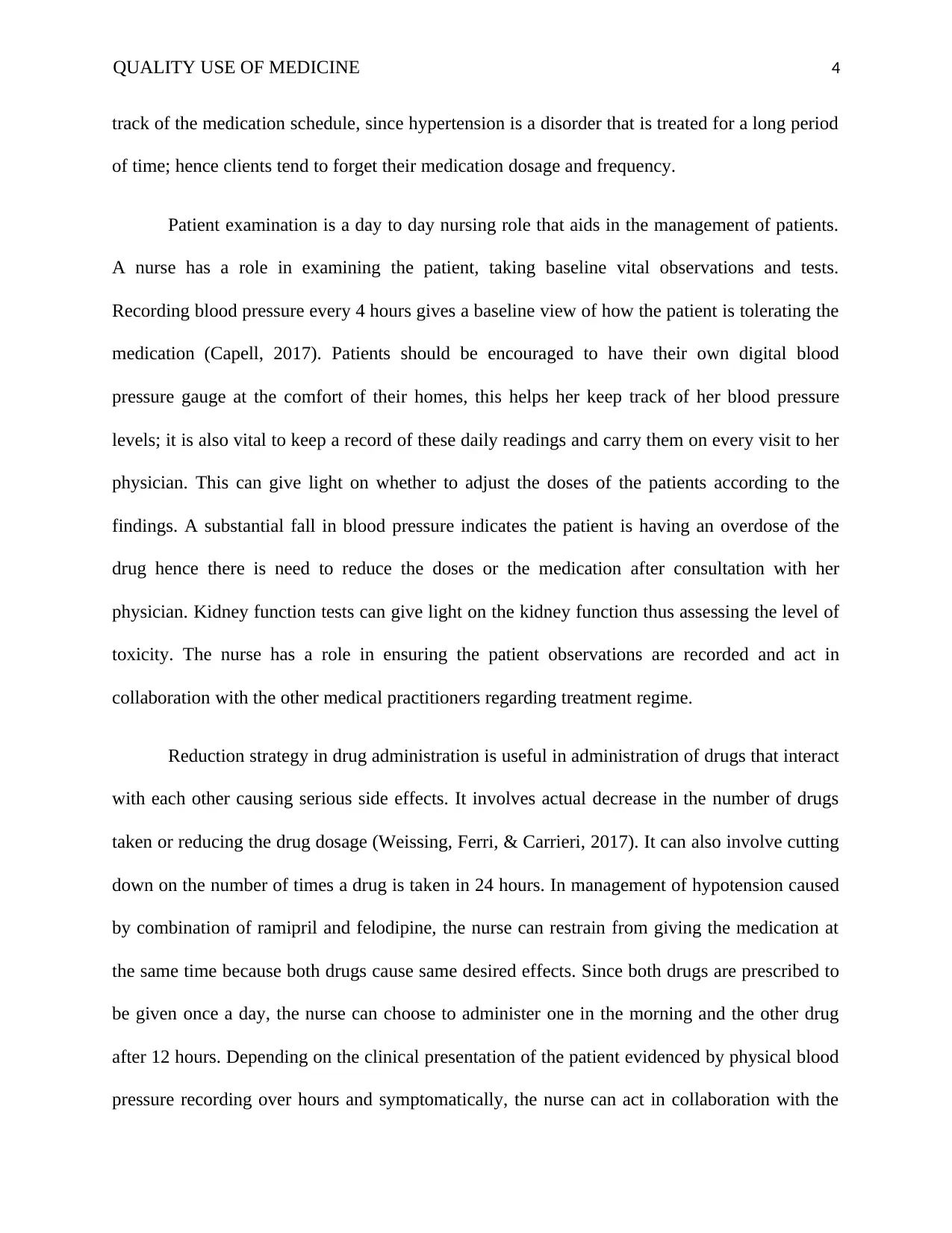
QUALITY USE OF MEDICINE 4
track of the medication schedule, since hypertension is a disorder that is treated for a long period
of time; hence clients tend to forget their medication dosage and frequency.
Patient examination is a day to day nursing role that aids in the management of patients.
A nurse has a role in examining the patient, taking baseline vital observations and tests.
Recording blood pressure every 4 hours gives a baseline view of how the patient is tolerating the
medication (Capell, 2017). Patients should be encouraged to have their own digital blood
pressure gauge at the comfort of their homes, this helps her keep track of her blood pressure
levels; it is also vital to keep a record of these daily readings and carry them on every visit to her
physician. This can give light on whether to adjust the doses of the patients according to the
findings. A substantial fall in blood pressure indicates the patient is having an overdose of the
drug hence there is need to reduce the doses or the medication after consultation with her
physician. Kidney function tests can give light on the kidney function thus assessing the level of
toxicity. The nurse has a role in ensuring the patient observations are recorded and act in
collaboration with the other medical practitioners regarding treatment regime.
Reduction strategy in drug administration is useful in administration of drugs that interact
with each other causing serious side effects. It involves actual decrease in the number of drugs
taken or reducing the drug dosage (Weissing, Ferri, & Carrieri, 2017). It can also involve cutting
down on the number of times a drug is taken in 24 hours. In management of hypotension caused
by combination of ramipril and felodipine, the nurse can restrain from giving the medication at
the same time because both drugs cause same desired effects. Since both drugs are prescribed to
be given once a day, the nurse can choose to administer one in the morning and the other drug
after 12 hours. Depending on the clinical presentation of the patient evidenced by physical blood
pressure recording over hours and symptomatically, the nurse can act in collaboration with the
track of the medication schedule, since hypertension is a disorder that is treated for a long period
of time; hence clients tend to forget their medication dosage and frequency.
Patient examination is a day to day nursing role that aids in the management of patients.
A nurse has a role in examining the patient, taking baseline vital observations and tests.
Recording blood pressure every 4 hours gives a baseline view of how the patient is tolerating the
medication (Capell, 2017). Patients should be encouraged to have their own digital blood
pressure gauge at the comfort of their homes, this helps her keep track of her blood pressure
levels; it is also vital to keep a record of these daily readings and carry them on every visit to her
physician. This can give light on whether to adjust the doses of the patients according to the
findings. A substantial fall in blood pressure indicates the patient is having an overdose of the
drug hence there is need to reduce the doses or the medication after consultation with her
physician. Kidney function tests can give light on the kidney function thus assessing the level of
toxicity. The nurse has a role in ensuring the patient observations are recorded and act in
collaboration with the other medical practitioners regarding treatment regime.
Reduction strategy in drug administration is useful in administration of drugs that interact
with each other causing serious side effects. It involves actual decrease in the number of drugs
taken or reducing the drug dosage (Weissing, Ferri, & Carrieri, 2017). It can also involve cutting
down on the number of times a drug is taken in 24 hours. In management of hypotension caused
by combination of ramipril and felodipine, the nurse can restrain from giving the medication at
the same time because both drugs cause same desired effects. Since both drugs are prescribed to
be given once a day, the nurse can choose to administer one in the morning and the other drug
after 12 hours. Depending on the clinical presentation of the patient evidenced by physical blood
pressure recording over hours and symptomatically, the nurse can act in collaboration with the
Paraphrase This Document
Need a fresh take? Get an instant paraphrase of this document with our AI Paraphraser
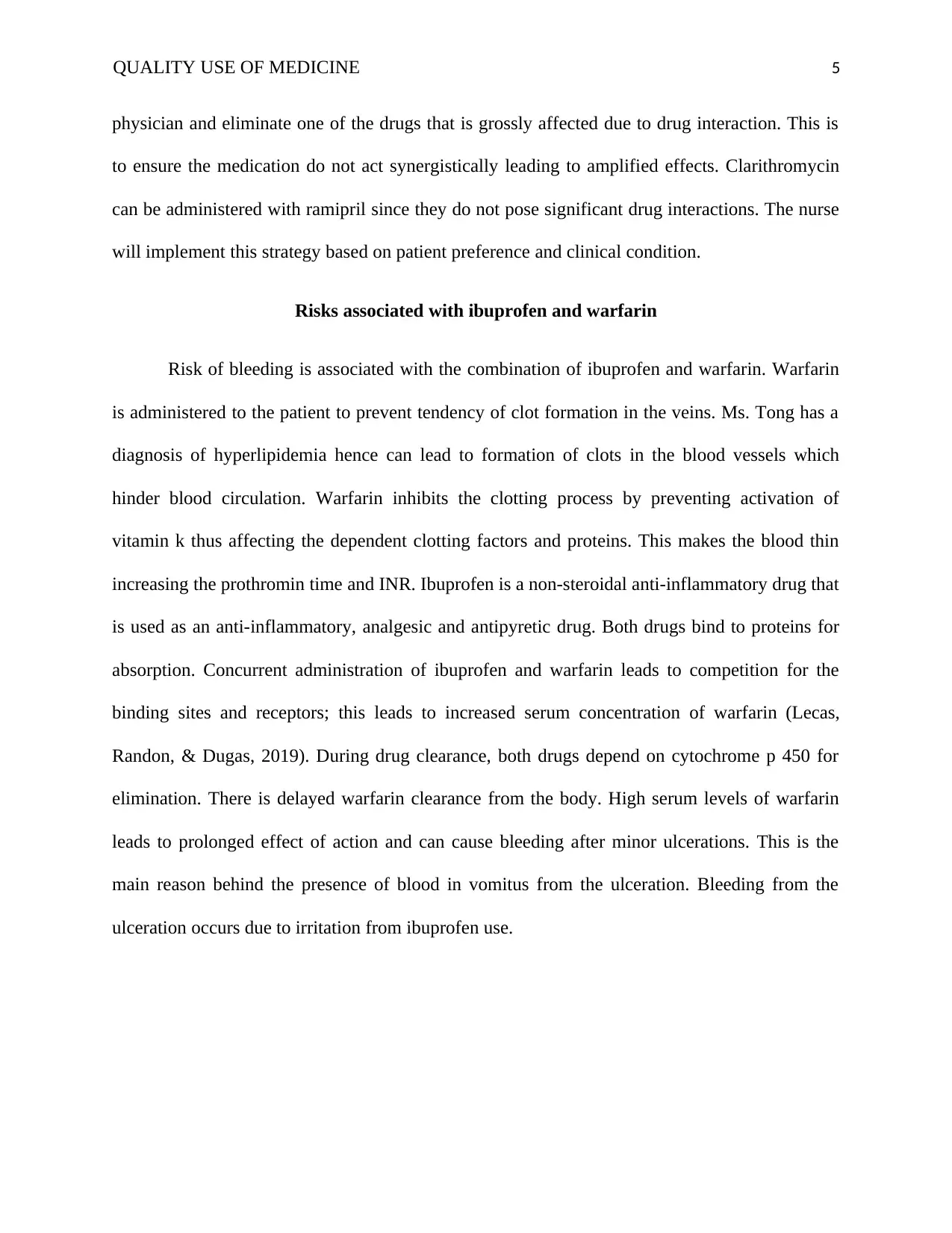
QUALITY USE OF MEDICINE 5
physician and eliminate one of the drugs that is grossly affected due to drug interaction. This is
to ensure the medication do not act synergistically leading to amplified effects. Clarithromycin
can be administered with ramipril since they do not pose significant drug interactions. The nurse
will implement this strategy based on patient preference and clinical condition.
Risks associated with ibuprofen and warfarin
Risk of bleeding is associated with the combination of ibuprofen and warfarin. Warfarin
is administered to the patient to prevent tendency of clot formation in the veins. Ms. Tong has a
diagnosis of hyperlipidemia hence can lead to formation of clots in the blood vessels which
hinder blood circulation. Warfarin inhibits the clotting process by preventing activation of
vitamin k thus affecting the dependent clotting factors and proteins. This makes the blood thin
increasing the prothromin time and INR. Ibuprofen is a non-steroidal anti-inflammatory drug that
is used as an anti-inflammatory, analgesic and antipyretic drug. Both drugs bind to proteins for
absorption. Concurrent administration of ibuprofen and warfarin leads to competition for the
binding sites and receptors; this leads to increased serum concentration of warfarin (Lecas,
Randon, & Dugas, 2019). During drug clearance, both drugs depend on cytochrome p 450 for
elimination. There is delayed warfarin clearance from the body. High serum levels of warfarin
leads to prolonged effect of action and can cause bleeding after minor ulcerations. This is the
main reason behind the presence of blood in vomitus from the ulceration. Bleeding from the
ulceration occurs due to irritation from ibuprofen use.
physician and eliminate one of the drugs that is grossly affected due to drug interaction. This is
to ensure the medication do not act synergistically leading to amplified effects. Clarithromycin
can be administered with ramipril since they do not pose significant drug interactions. The nurse
will implement this strategy based on patient preference and clinical condition.
Risks associated with ibuprofen and warfarin
Risk of bleeding is associated with the combination of ibuprofen and warfarin. Warfarin
is administered to the patient to prevent tendency of clot formation in the veins. Ms. Tong has a
diagnosis of hyperlipidemia hence can lead to formation of clots in the blood vessels which
hinder blood circulation. Warfarin inhibits the clotting process by preventing activation of
vitamin k thus affecting the dependent clotting factors and proteins. This makes the blood thin
increasing the prothromin time and INR. Ibuprofen is a non-steroidal anti-inflammatory drug that
is used as an anti-inflammatory, analgesic and antipyretic drug. Both drugs bind to proteins for
absorption. Concurrent administration of ibuprofen and warfarin leads to competition for the
binding sites and receptors; this leads to increased serum concentration of warfarin (Lecas,
Randon, & Dugas, 2019). During drug clearance, both drugs depend on cytochrome p 450 for
elimination. There is delayed warfarin clearance from the body. High serum levels of warfarin
leads to prolonged effect of action and can cause bleeding after minor ulcerations. This is the
main reason behind the presence of blood in vomitus from the ulceration. Bleeding from the
ulceration occurs due to irritation from ibuprofen use.
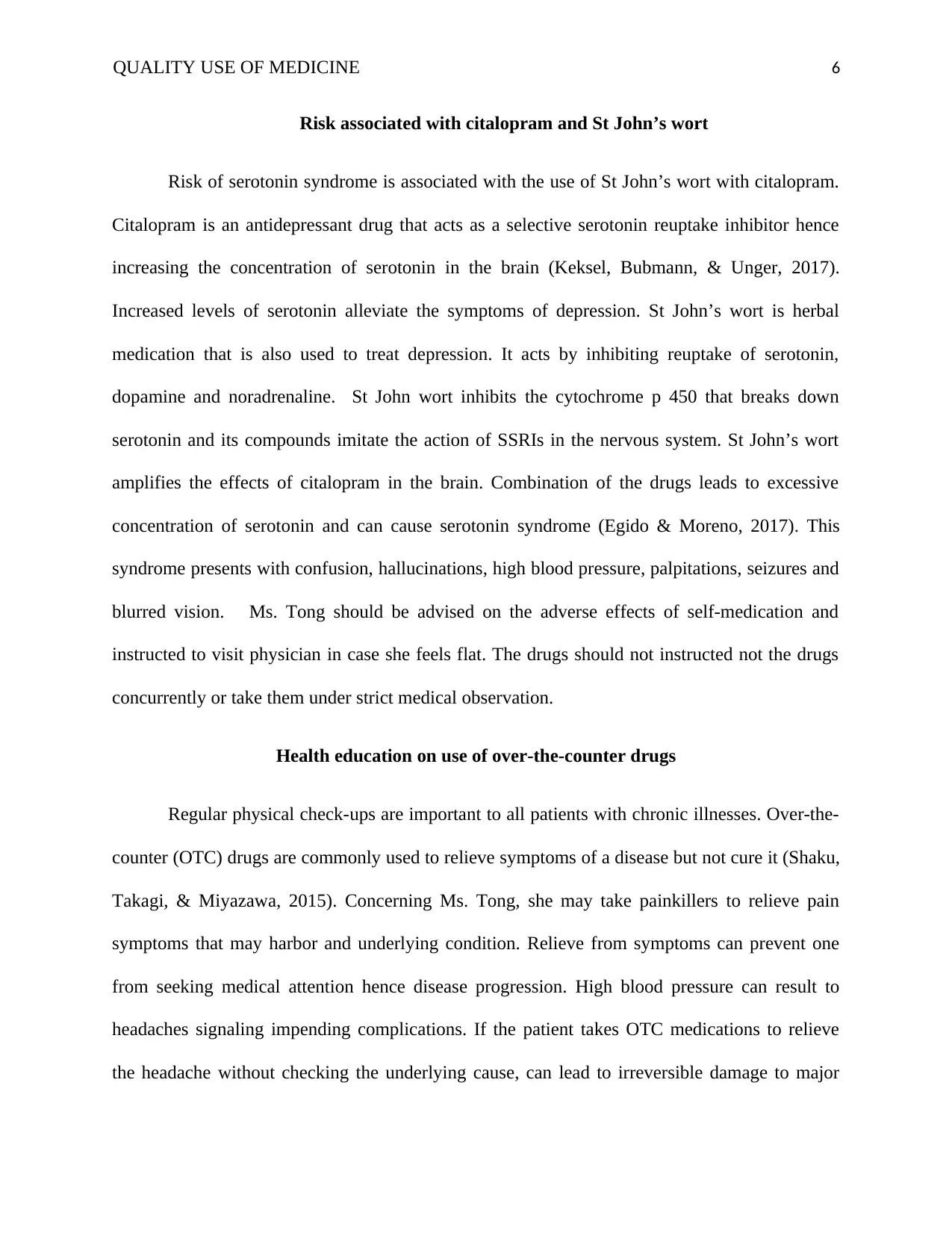
QUALITY USE OF MEDICINE 6
Risk associated with citalopram and St John’s wort
Risk of serotonin syndrome is associated with the use of St John’s wort with citalopram.
Citalopram is an antidepressant drug that acts as a selective serotonin reuptake inhibitor hence
increasing the concentration of serotonin in the brain (Keksel, Bubmann, & Unger, 2017).
Increased levels of serotonin alleviate the symptoms of depression. St John’s wort is herbal
medication that is also used to treat depression. It acts by inhibiting reuptake of serotonin,
dopamine and noradrenaline. St John wort inhibits the cytochrome p 450 that breaks down
serotonin and its compounds imitate the action of SSRIs in the nervous system. St John’s wort
amplifies the effects of citalopram in the brain. Combination of the drugs leads to excessive
concentration of serotonin and can cause serotonin syndrome (Egido & Moreno, 2017). This
syndrome presents with confusion, hallucinations, high blood pressure, palpitations, seizures and
blurred vision. Ms. Tong should be advised on the adverse effects of self-medication and
instructed to visit physician in case she feels flat. The drugs should not instructed not the drugs
concurrently or take them under strict medical observation.
Health education on use of over-the-counter drugs
Regular physical check-ups are important to all patients with chronic illnesses. Over-the-
counter (OTC) drugs are commonly used to relieve symptoms of a disease but not cure it (Shaku,
Takagi, & Miyazawa, 2015). Concerning Ms. Tong, she may take painkillers to relieve pain
symptoms that may harbor and underlying condition. Relieve from symptoms can prevent one
from seeking medical attention hence disease progression. High blood pressure can result to
headaches signaling impending complications. If the patient takes OTC medications to relieve
the headache without checking the underlying cause, can lead to irreversible damage to major
Risk associated with citalopram and St John’s wort
Risk of serotonin syndrome is associated with the use of St John’s wort with citalopram.
Citalopram is an antidepressant drug that acts as a selective serotonin reuptake inhibitor hence
increasing the concentration of serotonin in the brain (Keksel, Bubmann, & Unger, 2017).
Increased levels of serotonin alleviate the symptoms of depression. St John’s wort is herbal
medication that is also used to treat depression. It acts by inhibiting reuptake of serotonin,
dopamine and noradrenaline. St John wort inhibits the cytochrome p 450 that breaks down
serotonin and its compounds imitate the action of SSRIs in the nervous system. St John’s wort
amplifies the effects of citalopram in the brain. Combination of the drugs leads to excessive
concentration of serotonin and can cause serotonin syndrome (Egido & Moreno, 2017). This
syndrome presents with confusion, hallucinations, high blood pressure, palpitations, seizures and
blurred vision. Ms. Tong should be advised on the adverse effects of self-medication and
instructed to visit physician in case she feels flat. The drugs should not instructed not the drugs
concurrently or take them under strict medical observation.
Health education on use of over-the-counter drugs
Regular physical check-ups are important to all patients with chronic illnesses. Over-the-
counter (OTC) drugs are commonly used to relieve symptoms of a disease but not cure it (Shaku,
Takagi, & Miyazawa, 2015). Concerning Ms. Tong, she may take painkillers to relieve pain
symptoms that may harbor and underlying condition. Relieve from symptoms can prevent one
from seeking medical attention hence disease progression. High blood pressure can result to
headaches signaling impending complications. If the patient takes OTC medications to relieve
the headache without checking the underlying cause, can lead to irreversible damage to major
⊘ This is a preview!⊘
Do you want full access?
Subscribe today to unlock all pages.

Trusted by 1+ million students worldwide
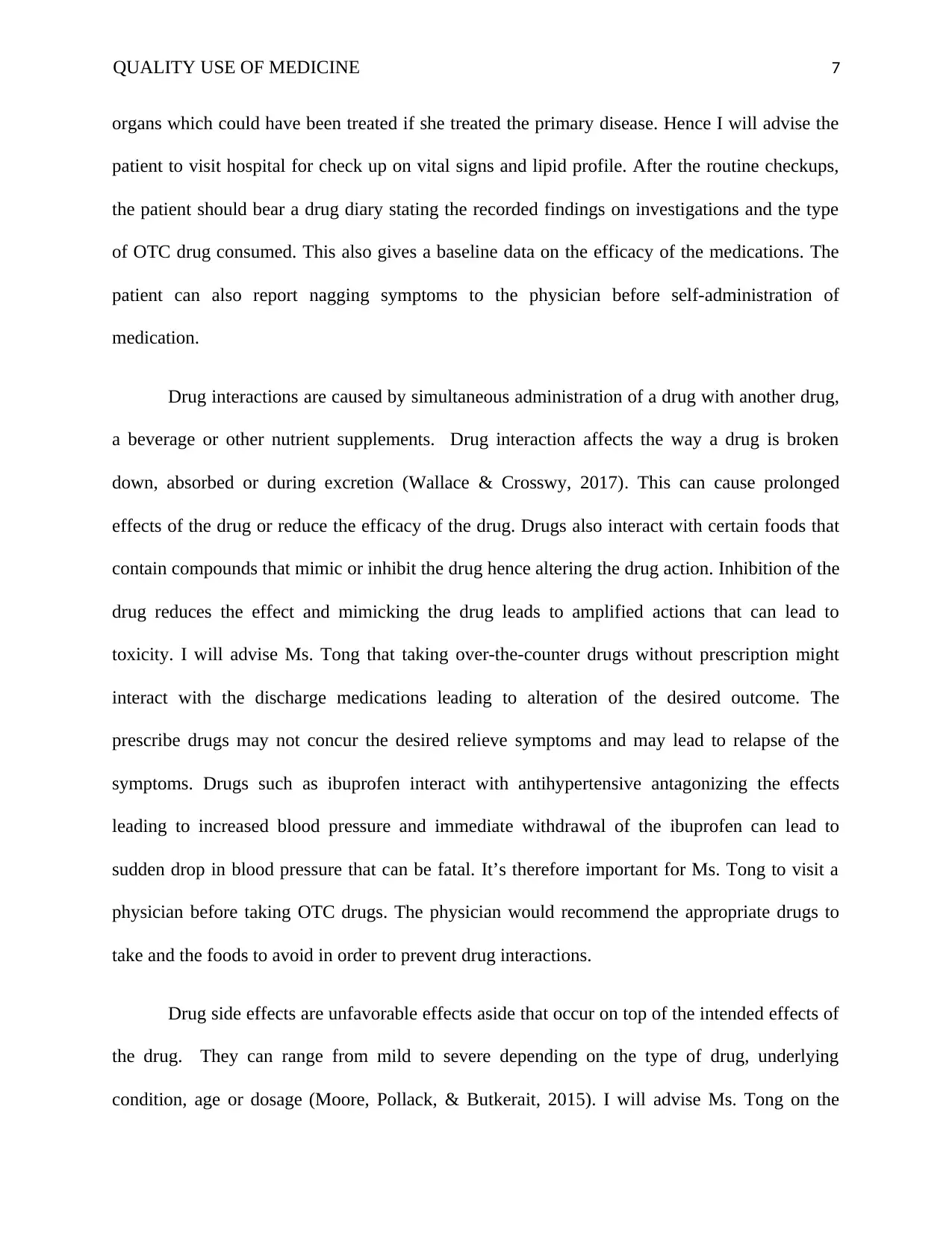
QUALITY USE OF MEDICINE 7
organs which could have been treated if she treated the primary disease. Hence I will advise the
patient to visit hospital for check up on vital signs and lipid profile. After the routine checkups,
the patient should bear a drug diary stating the recorded findings on investigations and the type
of OTC drug consumed. This also gives a baseline data on the efficacy of the medications. The
patient can also report nagging symptoms to the physician before self-administration of
medication.
Drug interactions are caused by simultaneous administration of a drug with another drug,
a beverage or other nutrient supplements. Drug interaction affects the way a drug is broken
down, absorbed or during excretion (Wallace & Crosswy, 2017). This can cause prolonged
effects of the drug or reduce the efficacy of the drug. Drugs also interact with certain foods that
contain compounds that mimic or inhibit the drug hence altering the drug action. Inhibition of the
drug reduces the effect and mimicking the drug leads to amplified actions that can lead to
toxicity. I will advise Ms. Tong that taking over-the-counter drugs without prescription might
interact with the discharge medications leading to alteration of the desired outcome. The
prescribe drugs may not concur the desired relieve symptoms and may lead to relapse of the
symptoms. Drugs such as ibuprofen interact with antihypertensive antagonizing the effects
leading to increased blood pressure and immediate withdrawal of the ibuprofen can lead to
sudden drop in blood pressure that can be fatal. It’s therefore important for Ms. Tong to visit a
physician before taking OTC drugs. The physician would recommend the appropriate drugs to
take and the foods to avoid in order to prevent drug interactions.
Drug side effects are unfavorable effects aside that occur on top of the intended effects of
the drug. They can range from mild to severe depending on the type of drug, underlying
condition, age or dosage (Moore, Pollack, & Butkerait, 2015). I will advise Ms. Tong on the
organs which could have been treated if she treated the primary disease. Hence I will advise the
patient to visit hospital for check up on vital signs and lipid profile. After the routine checkups,
the patient should bear a drug diary stating the recorded findings on investigations and the type
of OTC drug consumed. This also gives a baseline data on the efficacy of the medications. The
patient can also report nagging symptoms to the physician before self-administration of
medication.
Drug interactions are caused by simultaneous administration of a drug with another drug,
a beverage or other nutrient supplements. Drug interaction affects the way a drug is broken
down, absorbed or during excretion (Wallace & Crosswy, 2017). This can cause prolonged
effects of the drug or reduce the efficacy of the drug. Drugs also interact with certain foods that
contain compounds that mimic or inhibit the drug hence altering the drug action. Inhibition of the
drug reduces the effect and mimicking the drug leads to amplified actions that can lead to
toxicity. I will advise Ms. Tong that taking over-the-counter drugs without prescription might
interact with the discharge medications leading to alteration of the desired outcome. The
prescribe drugs may not concur the desired relieve symptoms and may lead to relapse of the
symptoms. Drugs such as ibuprofen interact with antihypertensive antagonizing the effects
leading to increased blood pressure and immediate withdrawal of the ibuprofen can lead to
sudden drop in blood pressure that can be fatal. It’s therefore important for Ms. Tong to visit a
physician before taking OTC drugs. The physician would recommend the appropriate drugs to
take and the foods to avoid in order to prevent drug interactions.
Drug side effects are unfavorable effects aside that occur on top of the intended effects of
the drug. They can range from mild to severe depending on the type of drug, underlying
condition, age or dosage (Moore, Pollack, & Butkerait, 2015). I will advise Ms. Tong on the
Paraphrase This Document
Need a fresh take? Get an instant paraphrase of this document with our AI Paraphraser
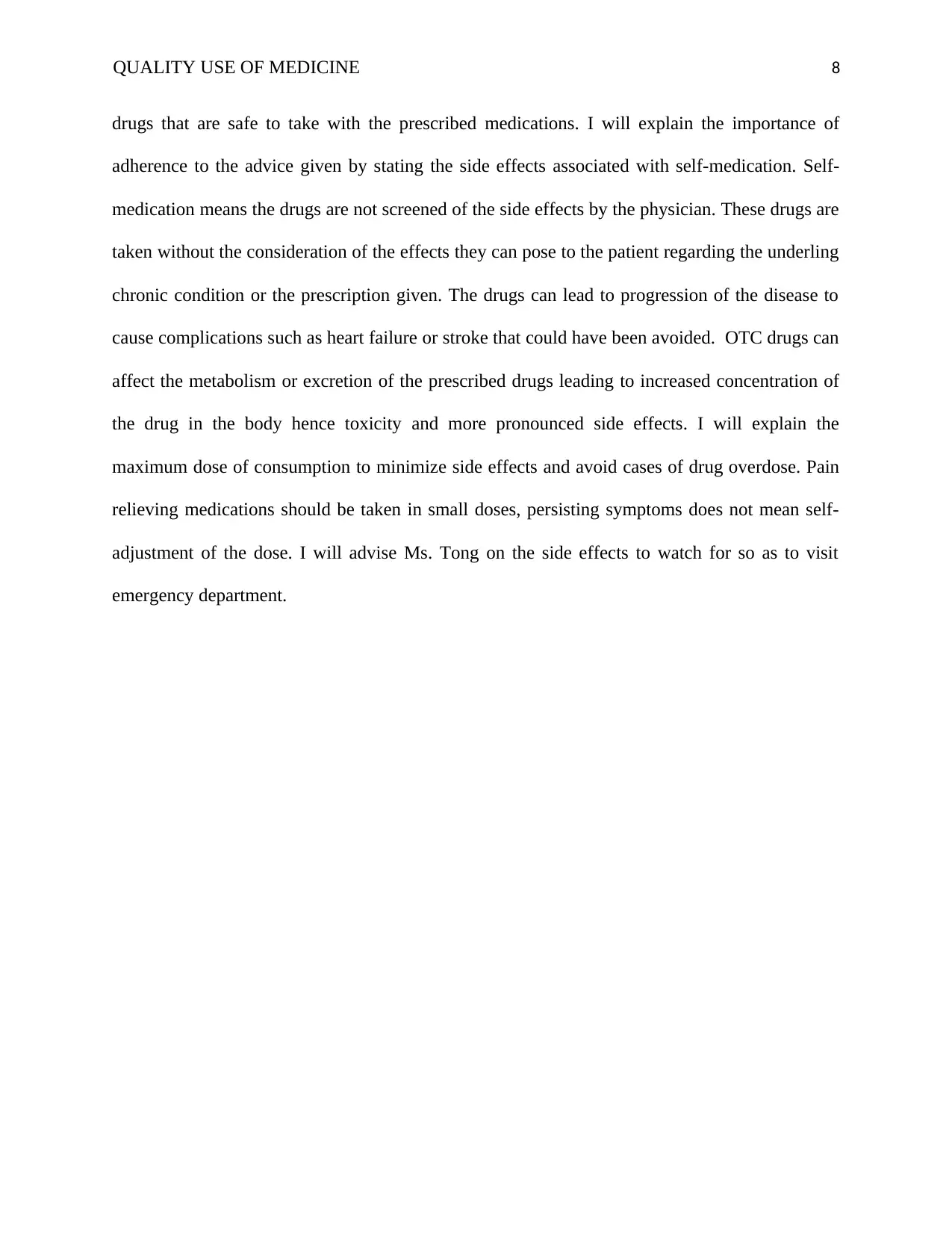
QUALITY USE OF MEDICINE 8
drugs that are safe to take with the prescribed medications. I will explain the importance of
adherence to the advice given by stating the side effects associated with self-medication. Self-
medication means the drugs are not screened of the side effects by the physician. These drugs are
taken without the consideration of the effects they can pose to the patient regarding the underling
chronic condition or the prescription given. The drugs can lead to progression of the disease to
cause complications such as heart failure or stroke that could have been avoided. OTC drugs can
affect the metabolism or excretion of the prescribed drugs leading to increased concentration of
the drug in the body hence toxicity and more pronounced side effects. I will explain the
maximum dose of consumption to minimize side effects and avoid cases of drug overdose. Pain
relieving medications should be taken in small doses, persisting symptoms does not mean self-
adjustment of the dose. I will advise Ms. Tong on the side effects to watch for so as to visit
emergency department.
drugs that are safe to take with the prescribed medications. I will explain the importance of
adherence to the advice given by stating the side effects associated with self-medication. Self-
medication means the drugs are not screened of the side effects by the physician. These drugs are
taken without the consideration of the effects they can pose to the patient regarding the underling
chronic condition or the prescription given. The drugs can lead to progression of the disease to
cause complications such as heart failure or stroke that could have been avoided. OTC drugs can
affect the metabolism or excretion of the prescribed drugs leading to increased concentration of
the drug in the body hence toxicity and more pronounced side effects. I will explain the
maximum dose of consumption to minimize side effects and avoid cases of drug overdose. Pain
relieving medications should be taken in small doses, persisting symptoms does not mean self-
adjustment of the dose. I will advise Ms. Tong on the side effects to watch for so as to visit
emergency department.
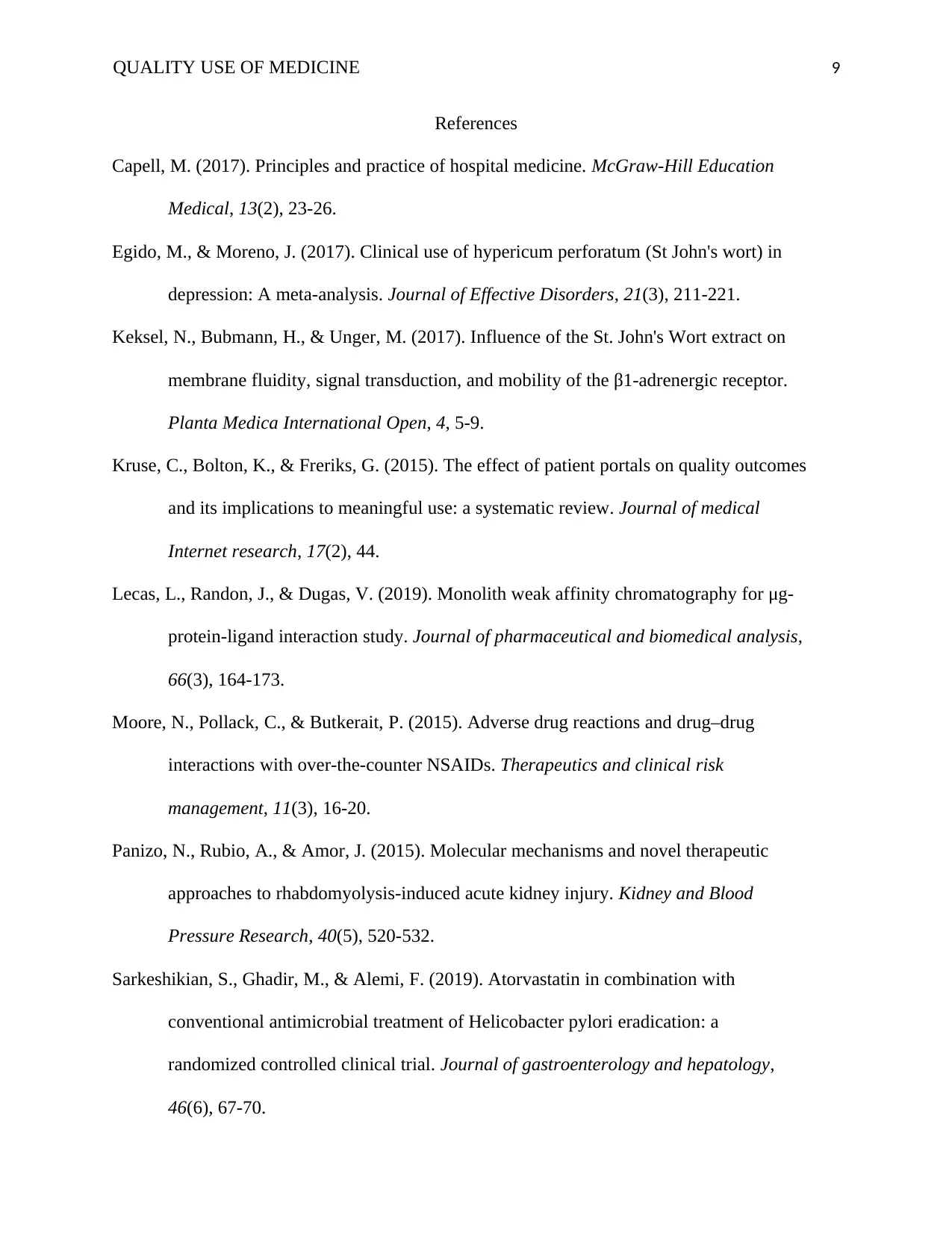
QUALITY USE OF MEDICINE 9
References
Capell, M. (2017). Principles and practice of hospital medicine. McGraw-Hill Education
Medical, 13(2), 23-26.
Egido, M., & Moreno, J. (2017). Clinical use of hypericum perforatum (St John's wort) in
depression: A meta-analysis. Journal of Effective Disorders, 21(3), 211-221.
Keksel, N., Bubmann, H., & Unger, M. (2017). Influence of the St. John's Wort extract on
membrane fluidity, signal transduction, and mobility of the β1-adrenergic receptor.
Planta Medica International Open, 4, 5-9.
Kruse, C., Bolton, K., & Freriks, G. (2015). The effect of patient portals on quality outcomes
and its implications to meaningful use: a systematic review. Journal of medical
Internet research, 17(2), 44.
Lecas, L., Randon, J., & Dugas, V. (2019). Monolith weak affinity chromatography for μg-
protein-ligand interaction study. Journal of pharmaceutical and biomedical analysis,
66(3), 164-173.
Moore, N., Pollack, C., & Butkerait, P. (2015). Adverse drug reactions and drug–drug
interactions with over-the-counter NSAIDs. Therapeutics and clinical risk
management, 11(3), 16-20.
Panizo, N., Rubio, A., & Amor, J. (2015). Molecular mechanisms and novel therapeutic
approaches to rhabdomyolysis-induced acute kidney injury. Kidney and Blood
Pressure Research, 40(5), 520-532.
Sarkeshikian, S., Ghadir, M., & Alemi, F. (2019). Atorvastatin in combination with
conventional antimicrobial treatment of Helicobacter pylori eradication: a
randomized controlled clinical trial. Journal of gastroenterology and hepatology,
46(6), 67-70.
References
Capell, M. (2017). Principles and practice of hospital medicine. McGraw-Hill Education
Medical, 13(2), 23-26.
Egido, M., & Moreno, J. (2017). Clinical use of hypericum perforatum (St John's wort) in
depression: A meta-analysis. Journal of Effective Disorders, 21(3), 211-221.
Keksel, N., Bubmann, H., & Unger, M. (2017). Influence of the St. John's Wort extract on
membrane fluidity, signal transduction, and mobility of the β1-adrenergic receptor.
Planta Medica International Open, 4, 5-9.
Kruse, C., Bolton, K., & Freriks, G. (2015). The effect of patient portals on quality outcomes
and its implications to meaningful use: a systematic review. Journal of medical
Internet research, 17(2), 44.
Lecas, L., Randon, J., & Dugas, V. (2019). Monolith weak affinity chromatography for μg-
protein-ligand interaction study. Journal of pharmaceutical and biomedical analysis,
66(3), 164-173.
Moore, N., Pollack, C., & Butkerait, P. (2015). Adverse drug reactions and drug–drug
interactions with over-the-counter NSAIDs. Therapeutics and clinical risk
management, 11(3), 16-20.
Panizo, N., Rubio, A., & Amor, J. (2015). Molecular mechanisms and novel therapeutic
approaches to rhabdomyolysis-induced acute kidney injury. Kidney and Blood
Pressure Research, 40(5), 520-532.
Sarkeshikian, S., Ghadir, M., & Alemi, F. (2019). Atorvastatin in combination with
conventional antimicrobial treatment of Helicobacter pylori eradication: a
randomized controlled clinical trial. Journal of gastroenterology and hepatology,
46(6), 67-70.
⊘ This is a preview!⊘
Do you want full access?
Subscribe today to unlock all pages.

Trusted by 1+ million students worldwide
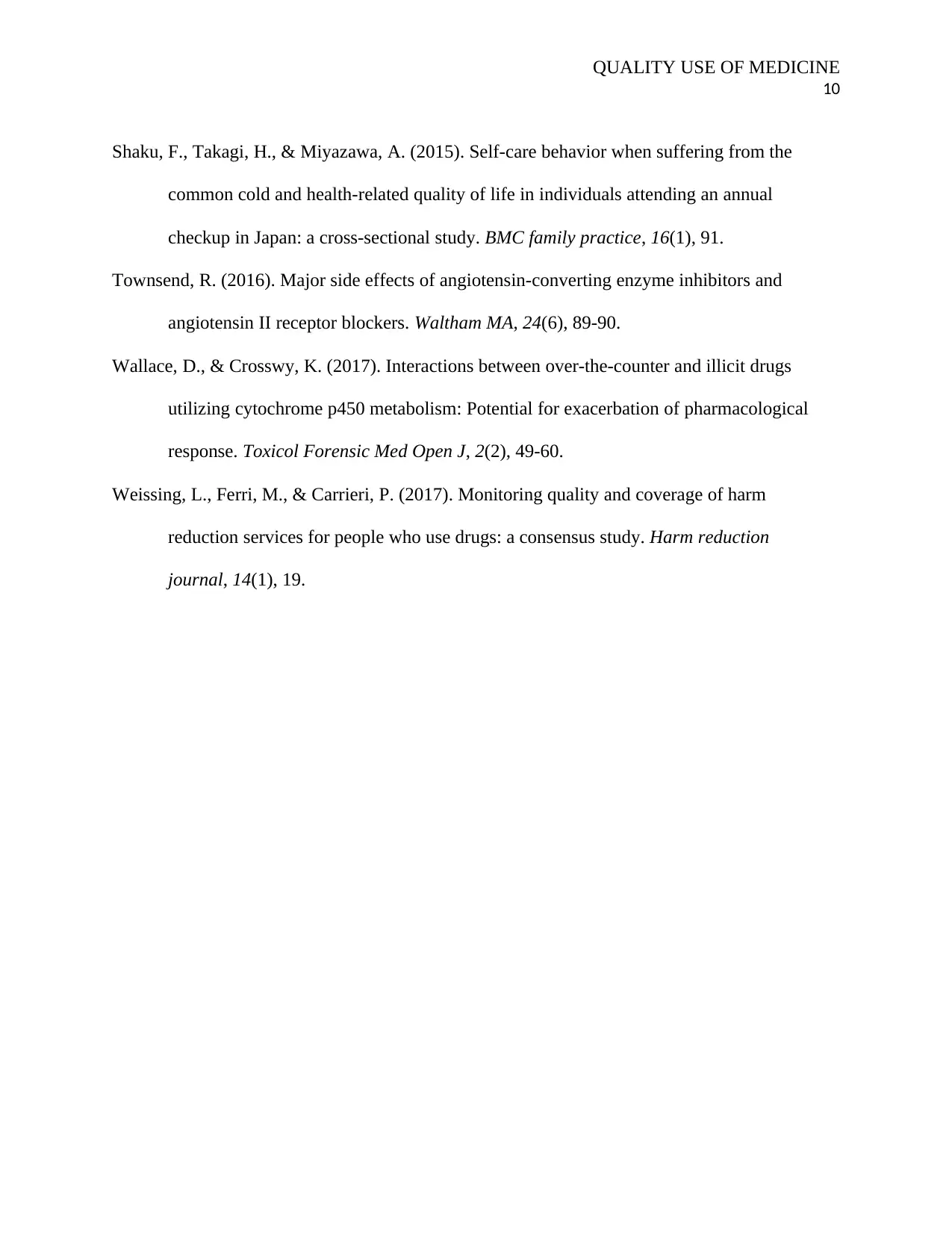
QUALITY USE OF MEDICINE
10
Shaku, F., Takagi, H., & Miyazawa, A. (2015). Self-care behavior when suffering from the
common cold and health-related quality of life in individuals attending an annual
checkup in Japan: a cross-sectional study. BMC family practice, 16(1), 91.
Townsend, R. (2016). Major side effects of angiotensin-converting enzyme inhibitors and
angiotensin II receptor blockers. Waltham MA, 24(6), 89-90.
Wallace, D., & Crosswy, K. (2017). Interactions between over-the-counter and illicit drugs
utilizing cytochrome p450 metabolism: Potential for exacerbation of pharmacological
response. Toxicol Forensic Med Open J, 2(2), 49-60.
Weissing, L., Ferri, M., & Carrieri, P. (2017). Monitoring quality and coverage of harm
reduction services for people who use drugs: a consensus study. Harm reduction
journal, 14(1), 19.
10
Shaku, F., Takagi, H., & Miyazawa, A. (2015). Self-care behavior when suffering from the
common cold and health-related quality of life in individuals attending an annual
checkup in Japan: a cross-sectional study. BMC family practice, 16(1), 91.
Townsend, R. (2016). Major side effects of angiotensin-converting enzyme inhibitors and
angiotensin II receptor blockers. Waltham MA, 24(6), 89-90.
Wallace, D., & Crosswy, K. (2017). Interactions between over-the-counter and illicit drugs
utilizing cytochrome p450 metabolism: Potential for exacerbation of pharmacological
response. Toxicol Forensic Med Open J, 2(2), 49-60.
Weissing, L., Ferri, M., & Carrieri, P. (2017). Monitoring quality and coverage of harm
reduction services for people who use drugs: a consensus study. Harm reduction
journal, 14(1), 19.
1 out of 10
Related Documents
Your All-in-One AI-Powered Toolkit for Academic Success.
+13062052269
info@desklib.com
Available 24*7 on WhatsApp / Email
![[object Object]](/_next/static/media/star-bottom.7253800d.svg)
Unlock your academic potential
Copyright © 2020–2025 A2Z Services. All Rights Reserved. Developed and managed by ZUCOL.





